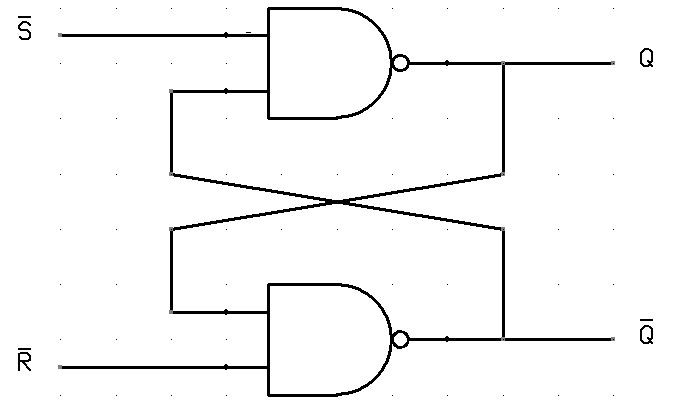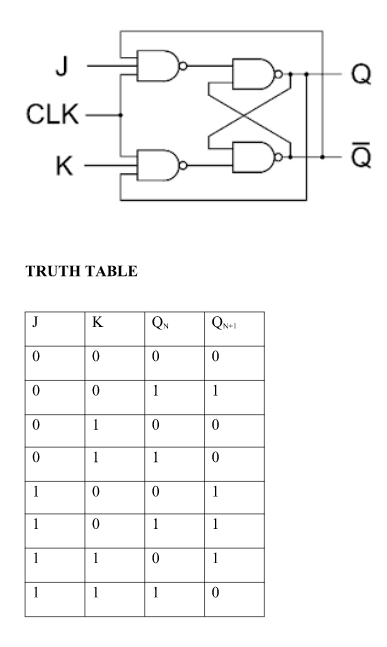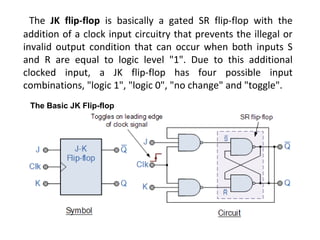Explain Different Types of Flip Flops in Computer Architecture
The main difference is that the intermediate state is more refined and precise than that of an S-R flip-flop. Types of Flip Flops.

Flip Flop Truth Table Various Types Basics For Beginners
For more understanding let us consider a case when S 0 and R 1 and the current output of both the gates are Q and Q respectively the 27 outputs are.

. They are able to store one bit of data. Flip flop circuits are classified into four types based on its use namely D-Flip Flop T- Flip Flop SR- Flip Flop and JK- Flip Flop. The characteristics of inputs J and K is same as the S and R inputs of the S-R flip-flop.
Master Slave JK Flip Flop. Often you will see latch circuits drawn with an. Some flip-flops are termed as latches.
Astable multivibrator monostable multivibrator and bistable multivibrator. A flip-flop circuit can be constructed from two NAND gates or two NOR gates. J-K flip-flop can be considered as a modification of the S-R flip-flop.
There are 4 basic types of flip flops-. When the clock rises from 0 to 1 the value remembered by the flip flop becomes the value of the D input Data at that instant. SR Flip Flop Truth.
- Flip flops are also known as bi-stable multi-vibrators. Is similar to an SR latch. The most common types of flip flops are.
The positive edge-triggered D flip-flop is a popular digital circuit component used in a variety of applications. A master slave flip flop contains two clocked flip flops. - Flip flops are able to be in two stable states namely one and zero.
They are able to store one bit of data. Asynchronous Up Down Counter. The D-type flip flop connected as in Figure 6 will thus operate as a T-type stage complementing each clock pulse.
- Flip flops are also known as bi-stable multi-vibrators. Flip Flops in Computer Architecture Tutorial Study Notes with Examples. Over time there have been many types of flip-flops developed including D flip-flop T flip-flop and JK flip-flop.
A Basic Flip-Flop. Master Slave Flip Flop. J stands for SET and K stands for CLEAR.
S-R flip-flop set-reset D flip-flop delay J-K flip-flop. To gain better understanding about Flip Flops in Digital Logic. LSum of setup time and Clk-output delay is the only true measure of the performance with.
While basic in design there were multiple varieties of these flip-flops. The S-R flip flop is the most common flip flop used in the digital system. The D flip-flop typically includes set and reset input signals that perform the same functions as in the.
The ops of the two AND gates remain at 0 as long as the CLK pulse is 0 irrespective of the S and R ip values. The register is used to perform different types of operations. SR Flip-Flop D Flip-Flop JK Flip-Flop T Flip-Flop Edge-Triggered Flip-Flop.
The only difference aroused between a latch and a flip-flop is the clock signal. - Certain flip flops are edge triggered meaning they only respond to voltage changes from one level to another. Latches are known for their non-clocked behavior.
In the context of hardware description languages the simple ones are commonly described as latches while the clocked ones are described as flip-flops. Master Slave JK Flip Flop. For storing a large number of bits the storage capacity is increased by grouping more than one flip flops.
There are several different types of flip-flops. The SR-flip flop is built with two AND gates and a basic NOR flip flop. In SR flip flop when the set input S is true the output Y will be high and Y will be low.
If the SET input is HIGH when the clock is. Figure 8 shows the schematic diagram of master sloave J-K flip flop. T Flip Flop.
Types of flip-flops. Flip-flops are similar to latches with the key difference being that the output of a flip-flop changes in response to a signal edge rather than responding to the signal level. - Certain flip flops are edge triggered meaning they only respond to voltage changes from one level to another.
In SR flip flop when the set input S is true the output Y will be high and Y will be low. We will discuss about these flip flops one by one. They can be in either states and in order to change their states they have to be driven by a trigger.
Flip flops are of different types depending on how their inputs and clock pulses cause transition between two states. If we want to store an n-bit word we have to use an n-bit register containing n number of flip flops. Master Slave JK Flip Flop.
The basic circuit that implements memory and time is called a latch which has two inputs set and reset and one output. D Flip Flop. There are four basic types of flip-flop circuits which are classified based on the number of inputs they possess and in the manner in which they affect the state of flip-flop.
The flip-flop because of its states is classified into four basic types. The latter variety was typical known as a flip-flop. Besides the CLOCK input an SR flip-flop has two inputs labeled SET and RESET.
- Flip flops are able to be in two stable states namely one and zero. They can be in either states and in order to change their states they have to be driven by a trigger. RS JK D and T flip-flops are the four basic types.
Know about their working and logic diagrams in detail. Latch Pair Master-Slave D Clk Q D Clk Q Clk Data D Clk Q Clk Data. A traditional simple flip-flop circuit based on bipolar junction transistors.
RS Flip Flop JK Flip Flop D Flip Flop T Flip Flop. Some of these are listed here. UC Berkeley EE241 B.
When the clock rises from 0 to 1 the value remembered by the flip flop either toggles or remains the same depending on whether the T input Toggle is 1 or 0. Flip-flops can be either simple transparent or asynchronous or clocked synchronous. Decade Counter BCD Counter RIng Counter and Johnsons Counter.
A flip flop is used to store single bit digital data.

Flip Flop Types Their Conversion And Applications Geeksforgeeks

Conversion Of Flip Flops From One Flip Flop To Another


No comments for "Explain Different Types of Flip Flops in Computer Architecture"
Post a Comment